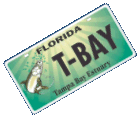
Just a drop in the bucket: This bright-eyed bullfrog was plucked from a bucket buried in the ground to trap amphibians and reptiles, part of a wildlife utilization study on reclaimed lands.
|
So far, the team has recorded 32 species of fish, 15 species of amphibians, 27 species of reptiles, 158 species of birds and 20 species of mammals. But numbers tell only part of the story. Researchers expect to see faster recovery of mobile animals such as birds, while other creatures, like gopher tortoises, must be relocated to establish a sustainable population.
“In areas where mining companies have spent the most money and where they have been required to reclaim to a higher level, we’re seeing a marked improvement in the number of species,” says Gonzalez. For the most part, reclamation has focused on wetlands so that’s where the most progress has occurred, he adds.
Only recently, in the last five to 10 years, have regulators embraced a more holistic approach that calls for recovery of a mosaic of habitats including uplands. “A lot of the reclamation in the past was piecemeal,” said Gonzalez. “Now we’re reclaiming ecosystems.”
Tools of the Trade
Getting the goods on all creatures great and small requires an arsenal of tools, some high tech, some low tech – and a little trickery.
To capture frogs and toads, researchers set up aluminum flashing that directs unsuspecting amphibians to buckets buried in the ground. The late-night ruse is carried out every three weeks in the rainy season over four-day sampling periods. Captive critters are identified and released unharmed.
Data on birds is gathered using “point counts” – researchers listen and watch at a specific point for a set amount of time, playing tapes that entice the birds to come and call.
Bats are detected using remote sensing devices that record their high-pitched shrieks, which are inaudible to the human ear. Squirrels and mice are baited with seeds in Sherman traps. Tree frogs seek cover in pvc pipes provided by researchers (in one pipe alone, 30 frogs had congregated), while snakes slither to the same buried buckets that collect frogs and toads – occasionally consuming their fellow inmates.
Fish are subjected to a mild form of electroshock that stuns them temporarily, long enough for researchers to scoop them up in a net, estimate a count and record species – a harmless technique that actually is less stressful on the animal than conventional net or hook-and-line fishing.
Large animals “require a bit more sleuthing,” says Gonzalez. By deploying infrared motion sensors with cameras, for instance, researchers are able to capture the nocturnal movements of deer, foxes, coyotes and bobcats. Animal droppings and tracks yield further clues.
Along with collecting data on animals, the team is also recording a wide array of site and habitat factors, include parcel size and age, reclamation method, vegetation and soil characteristics, and distance from natural to reclaimed sites.
Preliminary findings reveal an abundance and diversity of fish in reclaimed wetlands, which Gonzalez attributes to the enormous expanse of deep lakes and ponds that have been created. On the flip side, seasonal ponds and the breeding frogs that depend on them are still rare on reclaimed landscapes, although some mining companies are taking initiative to change that.
Still missing from the picture, by and large, are animals that require mature upland forest such as pine flatwoods and rarer xeric habitats, further evidence that reclamation of these habitats is still relatively new and needs more time to evolve.
At some sites, invasive Cuban tree frogs are taking up residence. Gonzalez suspects potted plants coming from nurseries may be harboring stowaways. As plants are transferred, nuisance frogs, known to hide in pots, are unwittingly relocated to restoration sites.
The $650,000 study was funded by the Florida Institute of Phosphate Research. A final report is expected in December 2006.
 |
|
Buy a Tampa Bay Estuary tag and help keep Tampa
Bay on the road to recovery. They’re available year round
in your local tax collector’s office or request a
Tampa Bay Estuary tag with your annual renewal. The cost is $27 for the first year and $17 after that – with $15 going directly to projects that benefit the estuary, including the publication of Bay Soundings.
A message from the Tampa Bay Estuary Program and the Tampa Bay Regional Planning Council ‘s Agency on Bay Management. Original artwork by Russ Sirmons |
|